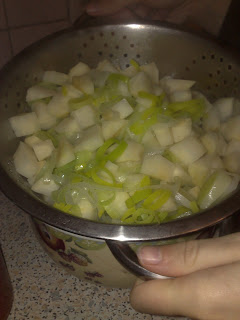Trips down the memory lane are frequent and things that cause these trips are sometimes as simple as a folded piece of paper or a distant sound of a train engine or as in this case, a cake. My Heinemann blog would have already revealed how much I like cakes and how much I want to learn baking, and now I am getting this opportunity to keep small steps into the world of baking. Thanks to my friend!
She did not tell me what we would be baking, but we bought the ingredients. Flour, sugar, vanilla sugar, raisins, sweetened orange peels, sliced and broken almonds, plant margarine and eggs. May be an expert baker can already guess the outcome and the look and the taste, but I couldnt. I was just eager to learn my first cake. And even when it was out from the oven, I did not recognize it until we cut it. Voila!! I was the six year old kid again. When I held the cake in my hands and sank my teeth into the grainy soft nutty mid section of this aromatic piece of nostalgia, I was not in Germany, but I was in YMCA. Wearing white shorts and a white shirt and after an hour long of gymnastic lessons with master Ismail, dad used to take me to the tea shop that stood near the bike parking. A simple tea shop with "Goldspot, the zing thing" scribbled all across and cartons of "Fruti" hanging in the windows and glass canisters filled with biscuits and cakes. They had these cakes and dad always used to buy this for me. One cup of tea. And they used to serve tea in a cup and saucer those days!
Separate the white from the yellow from 8 large eggs. Into the yellows, add 300 g of powdered sugar and whisk well until the sugar dissolves. Beat the egg whites until it is fluffy (until it does not fall down when you invert the bowl) and then fold the whites slowly into the well beaten yellow. Now add in 400 g of flour (Type 405) slowly with constant stirring. The resultant will be a thick batter, not a dough. Now goes in 10g of vanilla sugar for the mild flavor, 100 g raisins, 100 g sweetened orange peels and 100 g of the almonds. Mix well into the batter and then pour this into a nice oven able tray. Pre heat the oven at 200 C for 10 minutes and then bake this at 180 C for 90 minutes. Well, the time of baking depends on the efficiency of your oven. So it is a good idea to check if the cake is done after 60 minutes by driving a knife into the center and if the knife comes out without sticky batter, it is done! Dont worry if the top will become a bit black, you can always scrap it off and restore the baked brownness! Allow it to cool and then serve as slices. This cake can be stored for more than a week!
People who are baking egg less could find an alternative and post it to me ;-)













